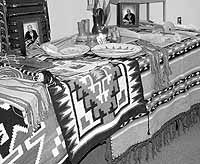| Examples of handmade rugs and baskets. |
The Museum of the San Rafael hosted its second presentation during the display of “Key Ingredients,” a traveling exhibit from the Smithsonian Institute sponsored by the Utah Humanities Council. This exhibit examines food in the American culture and the part it has played.
On the evening of June 17, the Joe and Shirley Begay family of Castle Dale presented an evening with the Navajo culture. Dressed in native clothing, the Begays told the audience about their culture and experiences growing up on the Navajo reservation.
Joe Begay began with an introduction to the Navajo religious beliefs and an explanation that some stories are only told during certain seasons of the year. He explained that he would tell what he could and that audience members would need to understand that there were some things he could not talk about.
Joe is the son of a medicine man, and so he grew up in a very structured home. The traditions were strictly adhered to and every member of the family knew what those traditions were and how to uphold them. Begay explained the morning prayers and the significance of the corn in the ceremonies at sunrise and sunset. The white corn is used to greet the morning and yellow corn is used during the evening ceremony.
Begay explained the significance of the four sacred mountains of the Navajo culture. To the West, there is Mt. San Francisco near Flagstaff, to the North, Blanca Mountain in Colorado, to the East, Mt. Hesperus, and to the South, there is Mt. Taylor. The four mountains are home to various gods, both male and female, and each are represented with a color and a stone.
“The mother is the center of the home,” he said. “She provides the nurturing and love.” His own mother was an interpreter of dreams.
Shirley Begay began her presentation with an introduction and explanation of the clans she is from. She explained that every time a Navajo meets someone new, they must introduce themselves and list their five clans. This is to ensure that everyone they meet knows where they fit and how they are related.
Shirley told the group about the food samples that had been prepared. The Navajos are nomadic in nature and move with their herds and the seasons, so they must know how to utilize the things in nature. The first item she explained was a tea she had made. It is made from the blossom of a plant native to the reservation and was a vivid red color.
Next, Shirley explained the breads, two of which were blue in color. Joe explained how to burn cedar wood and to utilize the ashes in the food to produce the blue tints. One of the blue breads was cooked in corn husks. All the foods were made from a corn base. The mutton stew had white and yellow hominy with other vegetables. Navajo fry bread, the most famous of the breads, was served with the stew also.
Vileena Begay, the oldest daughter in the family, recounted the history of Navajo dance and then demonstrated the hoop dance. When the dance was over, she told how she had traveled with Brigham Young University’s Living Legends dance troupe. She had toured with the troupe for the four years she attended BYU.
At the conclusion of the presentation, the audience was welcomed to the taster’s table. Everyone in attendance had the opportunity to sample the various foods that have sustained the Navajo culture.

